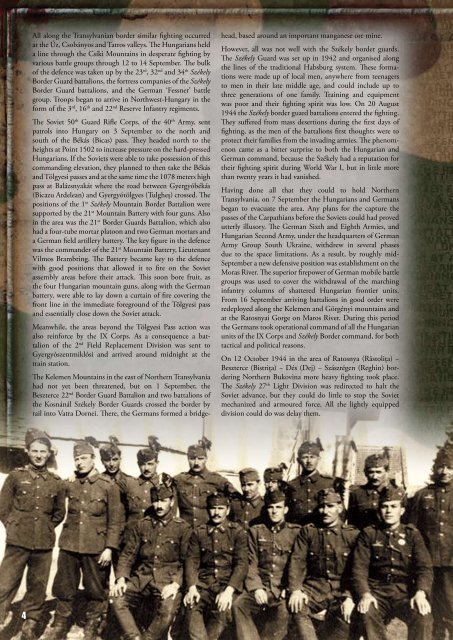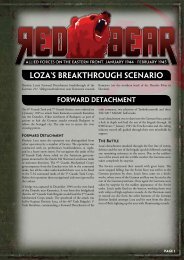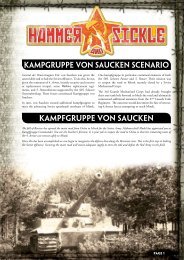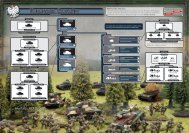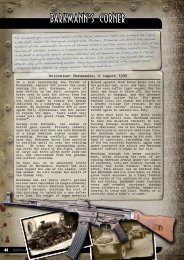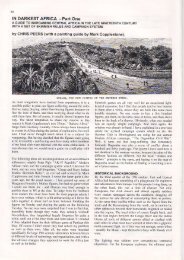Hungarian Infantry (PDF)... - Flames of War
Hungarian Infantry (PDF)... - Flames of War
Hungarian Infantry (PDF)... - Flames of War
You also want an ePaper? Increase the reach of your titles
YUMPU automatically turns print PDFs into web optimized ePapers that Google loves.
All along the Transylvanian border similar fighting occurred<br />
at the Úz, Csobányos and Tatros valleys. The <strong>Hungarian</strong>s held<br />
a line through the Csíki Mountains in desperate fighting by<br />
various battle groups through 12 to 14 September. The bulk<br />
<strong>of</strong> the defence was taken up by the 23 rd , 32 nd and 34 th Székely<br />
Border Guard battalions, the fortress companies <strong>of</strong> the Székely<br />
Border Guard battalions, and the German ‘Fessner’ battle<br />
group. Troops began to arrive in Northwest-Hungary in the<br />
form <strong>of</strong> the 3 rd , 16 th and 22 nd Reserve <strong>Infantry</strong> regiments.<br />
The Soviet 50 th Guard Rifle Corps, <strong>of</strong> the 40 th Army, sent<br />
patrols into Hungary on 3 September to the north and<br />
south <strong>of</strong> the Békás (Bicas) pass. They headed north to the<br />
heights at Point 1502 to increase pressure on the hard-pressed<br />
<strong>Hungarian</strong>s. If the Soviets were able to take possession <strong>of</strong> this<br />
commanding elevation, they planned to then take the Békás<br />
and Tölgyesi passes and at the same time the 1078 meters high<br />
pass at Balázsnyakát where the road between Gyergyóbékás<br />
(Bicazu Ardelean) and Gyergyótölgyes (Tulgheş) crossed. The<br />
positions <strong>of</strong> the 1 st Székely Mountain Border Battalion were<br />
supported by the 21 st Mountain Battery with four guns. Also<br />
in the area was the 21 st Border Guards Battalion, which also<br />
had a four-tube mortar platoon and two German mortars and<br />
a German field artillery battery. The key figure in the defence<br />
was the commander <strong>of</strong> the 21 st Mountain Battery, Lieutenant<br />
Vilmos Brambring. The Battery became key to the defence<br />
with good positions that allowed it to fire on the Soviet<br />
assembly areas before their attack. This soon bore fruit, as<br />
the four <strong>Hungarian</strong> mountain guns, along with the German<br />
battery, were able to lay down a curtain <strong>of</strong> fire covering the<br />
front line in the immediate foreground <strong>of</strong> the Tölgyesi pass<br />
and essentially close down the Soviet attack.<br />
Meanwhile, the areas beyond the Tölgyesi Pass action was<br />
also reinforce by the IX Corps. As a consequence a battalion<br />
<strong>of</strong> the 2 nd Field Replacement Division was sent to<br />
Gyergyószentmiklósi and arrived around midnight at the<br />
train station.<br />
The Kelemen Mountains in the east <strong>of</strong> Northern Transylvania<br />
had not yet been threatened, but on 1 September, the<br />
Beszterce 22 nd Border Guard Battalion and two battalions <strong>of</strong><br />
the Kosnánál Székely Border Guards crossed the border by<br />
rail into Vatra Dornei. There, the Germans formed a bridge-<br />
head, based around an important manganese ore mine.<br />
However, all was not well with the Székely border guards.<br />
The Székely Guard was set up in 1942 and organised along<br />
the lines <strong>of</strong> the traditional Habsburg system. These formations<br />
were made up <strong>of</strong> local men, anywhere from teenagers<br />
to men in their late middle age, and could include up to<br />
three generations <strong>of</strong> one family. Training and equipment<br />
was poor and their fighting spirit was low. On 20 August<br />
1944 the Székely border guard battalions entered the fighting.<br />
They suffered from mass desertions during the first days <strong>of</strong><br />
fighting, as the men <strong>of</strong> the battalions first thoughts were to<br />
protect their families from the invading armies. The phenomenon<br />
came as a bitter surprise to both the <strong>Hungarian</strong> and<br />
German command, because the Székely had a reputation for<br />
their fighting spirit during World <strong>War</strong> I, but in little more<br />
than twenty years it had vanished.<br />
Having done all that they could to hold Northern<br />
Transylvania, on 7 September the <strong>Hungarian</strong>s and Germans<br />
began to evacuate the area. Any plans for the capture the<br />
passes <strong>of</strong> the Carpathians before the Soviets could had proved<br />
utterly illusory. The German Sixth and Eighth Armies, and<br />
<strong>Hungarian</strong> Second Army, under the headquarters <strong>of</strong> German<br />
Army Group South Ukraine, withdrew in several phases<br />
due to the space limitations. As a result, by roughly mid-<br />
September a new defensive position was establishment on the<br />
Moras River. The superior firepower <strong>of</strong> German mobile battle<br />
groups was used to cover the withdrawal <strong>of</strong> the marching<br />
infantry columns <strong>of</strong> shattered <strong>Hungarian</strong> frontier units.<br />
From 16 September arriving battalions in good order were<br />
redeployed along the Kelemen and Görgényi mountains and<br />
at the Ratosnyai Gorge on Maros River. During this period<br />
the Germans took operational command <strong>of</strong> all the <strong>Hungarian</strong><br />
units <strong>of</strong> the IX Corps and Székely Border command, for both<br />
tactical and political reasons.<br />
On 12 October 1944 in the area <strong>of</strong> Ratosnya (Răstoliţa) −<br />
Beszterce (Bistriţa) − Dés (Dej) − Szászrégen (Reghin) bordering<br />
Northern Bukovina more heavy fighting took place.<br />
The Székely 27 th Light Division was redirected to halt the<br />
Soviet advance, but they could do little to stop the Soviet<br />
mechanized and armoured force. All the lightly equipped<br />
division could do was delay them.


